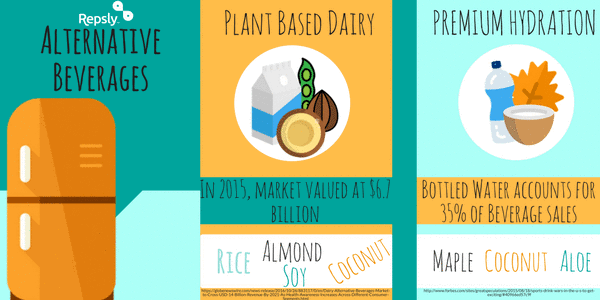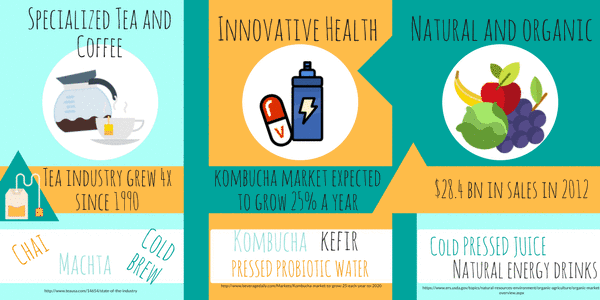Boring old juices and sodas aren’t cutting it anymore. The rise of alternative beverages is taking the food and beverage industry by storm. Sugars, byproducts, and artificial ingredients are going the way of the dinosaurs as innovative, healthy and natural products replace beverages loaded with unnatural fillers. As the consumer market gravitates towards trendier beverages, companies are rethinking what it means to be a beverage brand.
What Is an Alternative Beverage?
An alternative beverage is any non-alcoholic drink with non-traditional ingredients. They promote well-being and typically have an added health benefit. These benefits can range from increased energy to hydration to probiotic power. A few examples of alternative beverages are sports drinks, energy drinks and plant-based waters.
The emergence of energy drinks, sports drinks, and health focused beverages paved the way for an entire movement of drinks providing a specific function.
Companies like Red Bull and Glaceau, contributors to the rise of alternative beverages, opened the market by not only initiating the demand for new options but also by pointing to areas of the industry that could be improved or expanded upon. As the pioneers in vitamin-based beverages and energy drinks, the two companies proved that people wanted something more from their beverages. In doing so they tapped into consumer interests that would help drive the alternative beverage industry to what it is today.
Glaceau's Vitamin Water brand was an early standout in the functional beverage market.
The Market for Alternative Beverages
As consumers receive more information about the quality of their food and beverage products, they are becoming more conscientious of what they choose to put in their bodies. The internet is no doubt a huge factor in this movement of consumer values.
Eighty-one percent of internet users affirmed that the internet keeps them better informed about what products they should buy, found Pew Research. By means of recent technology, improved access to information encourages the emergence of the health-savvy consumer.
Beverage giants such as Coca-Cola, Pepsi Co. and Dr. Pepper Snapple Group are rethinking their product lines alongside the changing consumer base. In 2007, Coca-Cola acquired Glaceau for $4.1B, while Dr. Pepper Snapple Group bought Bai Brands for $1.7B. These large acquisitions hint at the developing and growing market for alternative beverages. Traditional soft drink producers recognize changing consumer interests, and consequently are rebranding themselves from a healthier angle.
On average, consumers spend $217 a year on refreshments, but those looking for natural beverages spent $30 more a year, reported IRi. The increase reflects a willingness to spend more on products that can prove their worth, whether it be through organic and non-GMO ingredients, a vitamin kick, or whatever benefit entices the adventurous alternative beverage shopper.
Global functional drinks are expected to grow at a compound annual growth rate (CAGR) of 8.77% between 2016 and 2017, found Technavio. As the market continues to expand, alternative beverages will flourish in new forms, providing a tasty drink that integrates function into consumers' routines.
Alternative Beverage Industry Trends
Plant Based Milk
Plant based milk includes almond, coconut, soy and rice beverages. In 2015, the global market value of dairy alternatives was $6.7 billion, according to IndustryArc. You can see this trend coming to life in coffee shops around the country, as plain dairy milk is now only one of many options amidst a myriad of plant-based options.
Although soy milk still dominates the market, almond milk has experienced the largest growth in the U.S. Asia Pacific is the largest market for these alternatives, soy in particular. Plant-based milks are not only great for those who are lactose intolerant, but also offer an option for people who are vegetarians or looking to reduce consumption of animal-based products.

Premium Hydration
Consumers prioritize hydration in their beverages. Premium hydration includes specialty waters and beverages that are enhanced. Coconut water from companies like Vita Coco, SmartWater, and Voss exemplify the differentiation of water-based products to appeal to the diversifying beverage market. These products can differ from normal water in their flavor profile, source, or added minerals and vitamins. Some of these waters have specified pH levels that designate them as alkaline. Other examples of alternative waters include aloe and maple water.
Premium hydration beverages are for the consumer looking to move away from traditional water but still achieve the same hydration without the additives present in some hydrating beverages. By 2019, the global flavored and functional water market will reach $36 billion, First Beverage reported.
Encompassing the enhancements of regular water and plant-based beverages, premium hydration will only rise in popularity as health professionals continue to stress the importance of getting your eight glasses of H2O a day. It provides a great substitute for people wanting to shake up their routine or maximize nutrient consumption.
Twists on Classic Tea and Coffee
Plain coffee and tea, in spite of the caffeine, is dull enough to put you to sleep. It’s been done as many times and in as many ways as it seems possible. Yet, the alternative beverage trend has revolutionized the way we consume even these standard drinks. Teas explode with health benefits such as antioxidants, anti-aging, weight loss and cancer prevention. It’s no wonder beverage companies are experimenting with their nourishing leaves.
Since 1990, the tea industry has quadrupled from $1.8 billion to $10.8 billion, according to the Tea Association of the USA. Latte inspired teas from matcha to chai are popping up in coffee shops around the country, providing a delicious and nutritious option to plain, steeped tea
In both coffee and tea, specialty iced versions of the beverages are on the rise. Fifty-five percent of spending in the coffee market will go to specialty coffee. Cold brew coffee is one of industry’s hottest iced trends. Sales have skyrocketed within the past five years for this smooth and cool drink, and are projected to rise through the coming year.
Innovative Health Beverages
Packing probiotics and antioxidants into beverages delivers. The probiotics drinks market is expected to have a CAGR of 7%, according to TechNavio. Kombucha beverages are a key player in the innovative health beverage category. It is fermented tea made from a mix of a bacteria culture, yeast, sugar, and tea. Different flavors such as fruit juices can be added. It packs probiotics that support digestive health, detoxing, weight loss and more.
The kombucha market is expected to grow 25% a year until 2020 reported Beverage Daily. Kevita, one of the leading kombucha companies in the industry, testifies to the importance of probiotics in daily diets. Healthy beverages like kombucha are easy to grab and go, and pump extra nutrients into your routine.
Natural and Organic Beverages
Consumers searching for less processed options are turning to natural and organic beverages free of additives and byproducts. In 2015, natural and organic food and beverage sales increased by 10.7%, reported Food Navigator USA. More studies expose the consequences of synthesized and artificial ingredients leading to the rise of the natural and organic consumer.
Fifty-seven percent of Americans are concerned with the health implications of GMOs, found First Beverage. Nowadays, it is normal to find a whole section dedicated to this subsection of beverages. Natural and organic beverages have revamped classic products.
Craft sodas, for example, have swapped the ‘unknowns’ hiding in traditional soft drinks for natural ingredients and sweeteners. The villain isn’t sodas themselves, but rather the lack of discernable names on the ingredient label. The goal of natural and organic beverages is to take the beverages we have always loved and reassess how they are made.

Unsweetened Beverages
Sugar is the hidden enemy of health, often lurking in a slew of different beverages from juices to sodas. Artificial sweeteners, sneakier and more threatening, appear as low calorie and sugar free, yet have been linked to serious illnesses such as cancer and heart disease. In the plight of diet sodas and beverages, consumers are swapping their traditionally sweetened and artificially sweetened drinks for no-sugar-added products.
Soft drinks sales declined 1.2% in 2015, reaching its lowest in 30 years, according to Fortune. Flavored, unsweetened teas, sparkling waters, and even plain yogurt drinks are rising in popularity and replacing the sugar-packed beverages that stick to your waistline.
The demand for unsweetened beverages demonstrates the gaps in the initial products like Vitamin Water that were amongst the first in the alternative beverage movement. The unsweetened beverage trend allows for a new market of producers to deliver the same promise as Vitamin Water and capitalize on the opening to produce a beverage without the sugary content of Glaceau’s drinks.
Alternative beverage trends offer flavors for every palette and provide options for every need. They have the familiarity of your favorite, classic beverages but with the creativity to always keep you on your toes! Don’t get stuck in a rut of empty beverages. Get creative with these unique and healthy products. Ask what alternative beverages can do for you that dated beverages can’t.






